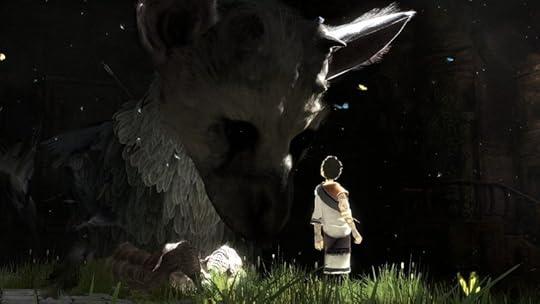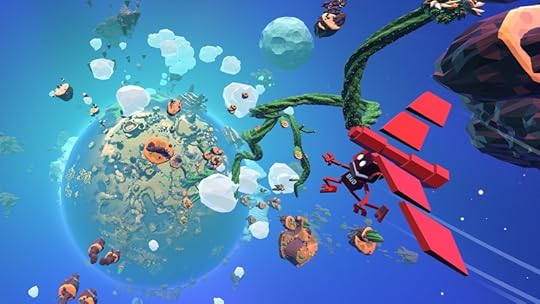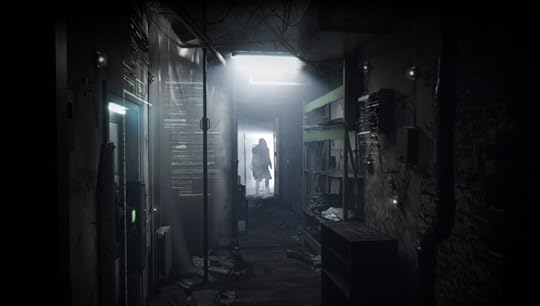Kill Screen Magazine's Blog, page 104
June 17, 2016
Joy Division lyrics become a virtual landscape of memory
Some songs stay with us, permanent signposts along the pathways of our memory. We revisit them in different contexts as time goes on, hearing the bass line or the lyrics or the production anew, reflecting on the significance of the moment from the comfort of the familiar.
Ansh Patel, an interdisciplinary artist who received his MFA in game design from NYU’s Tisch School of the Arts, recently released an experimental “interactive poem” on itch.io that he calls his “most explicitly autobiographical work,” combining fragments of memory with the music of Joy Division.
“appealed to the unrelenting burden of expectations I felt growing up”
Set to the 1979 song from which it takes its title, “New Dawn Fades” was made using the Unity engine to transform “memory into a texture,” says Patel. The track comes from the seminal post-punk group’s debut LP, Unknown Pleasures. The playable version of the video requires users to hold down the spacebar in order to progress forward through time, with the 2D player sprite growing accordingly, save for the occasional regression into the patterns of youth. “Intermittent splashes of color flash in sync with the audio waveform of the song,” Patel says, echoing frontman Ian Curtis’s lyric: “Different colors, different shades . . .”
Inspired by Nina Freeman’s Cibele (2015), Patel wanted to explore his own past through an interactive medium without being overly voyeuristic, so as to let the viewer recall some of their own memories as part of the experience. “There’s a certain malleability to the pathos that Joy Division evokes,” says Patel. “At many points in the song, Curtis is talking about a variety of things—his failing marriage, his anxiety on stage—but as a listener, I always [interpreted the meaning] in terms of the things that were weighing on my mind. When I discovered it in my teens, the song appealed to the unrelenting burden of expectations I felt growing up in a highly competitive schooling environment in India. There’s something about their music, particularly ‘New Dawn Fades,’ which appeals to aspects of the self that feel wronged by the world in some way.”
Find out more about Patel and his work at the artist’s website. You can play New Dawn Fades in your browser.
The post Joy Division lyrics become a virtual landscape of memory appeared first on Kill Screen.
Does Esports Even Need Network TV?
This article is part of a collaboration with iQ by Intel .
Broadcasting esports on TV is the latest craze, but the internet-born phenomenon may have already hit its stride live-streaming. Four decades after the first videogame competition, esports finally hit primetime television on May 27 with TBS’s ELeague. Interest in esports is skyrocketing around the world, but the question remains whether the excitement of videogame matchups, which thrill millions of fans via livestreaming on internet sites like Twitch and YouTube, will succeed on a cable television network. “Everybody is waiting with baited breath to see how ELeague is received,” said Matt Hill, senior vice president of Global Sports and Entertainment at GMR Marketing. Gaming tournaments have come a long way from their humble beginnings: Folklore has it that Stanford University students participated in the first esport, the “” in October 1972. Grand prize winners got a year’s subscription to Rolling Stone magazine.
Today, the world’s longest running esports tournament Intel Extreme Masters (IEM) attracts gamers compete for a prize pool of $1 million. The 2015 event in Katowice, Poland attracted 100,000 people and set an IEM record of one million concurrent viewers on Twitch. Enthusiasts and occasional viewers composed a huge audience even before a network put esports on TV. According to research firm Newzoo, audiences are expected to climb from 256 million in 2016 to more than 345 million by 2019. According to Hill, TBS could play a major role in that growth, especially by attracting new audiences to professional esports. The transition from streaming to live broadcasts presents unique challenges for the emerging sport but also massive opportunities.A lot more is riding on the first two seasons of ELeague (airing throughout the summer and featuring popular shooter Counter-Strike: Global Offensive) than the $1.2 million in prize money, said Hill. “The biggest benefit is from a perception standpoint,” he said. “[Being on television means] esports are no longer thought of as an underground industry.”
The transition from streaming to live broadcasts presents unique challenges
The live-streaming video platform Twitch draws in a staggering 8.5 million active users a day, and esports account for an equitable share of the viewership. With those numbers, many would argue that the digital sport has already reached the “mainstream,” whether it’s shown on TV or not. “At a time when the majority of traditional sports are trying to figure out how to solve the digital puzzle, you have esports, which have been born out of the digital space, now trying to go backwards into TV,” said Hill. But a successful run on the national stage could convince big (and still apprehensive) advertisers to enter the fray. And getting more major brands behind esports appears the next logical step to turning competitive gaming into a national pastime. For these potential advertisers, ELeague is more than just a broadcast. It’s the final testing ground.
The Twitch Takeover
ELeague is testing the waters with a 10-week gaming tournament that airs every Friday. The tournament includes 24 teams, all of which have won a Counter-Strike: Global Offensive tournament in the past year, playing the popular first-person shooter on air. Hopes are high that the tournament will flourish in its prime Friday night slot, but the esports community has its share of reservations about the limelight. Chiefly, TV may not be the right fit for a sport primarily consumed on the internet. “TV is a very structured medium—the ads, the right kind of commentators, the timing—it relies on consistency and repeatable structures,” said Gareth Martin, formerly a channel manager at the videogame-centric TV network Ginx.TV. To his point, a sport like professional basketball, with its clockwork regularity of quarters and halftime analyses, easily adapted to the television format. An esport match, on the other hand, can go on almost indefinitely or be over in the blink of an eye.
For some, Twitch seems like the best method for consuming headshots, knock outs, and pentakills (when players take down an opponent’s entire team). “Twitch was really born out of a true passion for esports,” said Andy Swanson, the VP of esports at Twitch. “Most people discovered and experienced esports on Twitch and continue to come back on a daily basis.” Twitch grew up alongside esports, rendering it a platform custom-tailored for the competitive gaming experience in many ways. For one thing, it eliminates barriers to entry for fans and pros alike. Regardless of skill level, players from all over the world can easily and instantly broadcast their matches and scrimmages. “The fact that Twitch focuses on the live experience and provides the opportunity for fans to interact with one another makes it the perfect platform,” Swanson said.
Twitch grew up alongside esports
Much like Facebook or Instagram, the Twitch interface also naturally fosters a sense of community. Fans can keep up with their favorite players and teams simply by subscribing to their channels. The chat window even allows them direct communication with players, other fans and rival camps. These internet-tailored features heighten not only the communal aspect, but the drama that remains so crucial to enjoying esports. Chats overflowing with fan reactions to “oh my god” moments is something TV struggles to replicate.
TV Strikes Back
But even with the disadvantages, esports may still have a place on broadcast TV. Traditional television cannot match the immediacy and adaptability of the internet, but the way people watch TV is evolving into a much more internet-enabled experience. According to the research of Professor Matthew Eastin of University of Texas at Austin, sports fans now use second devices such as tablets and phones to enhancement their engagement with televised sports. “People are able to immerse themselves in a franchise beyond being a fan who sits on the couch and says ‘Go team!’” he explained. “They are out there contributing to the community of the team itself.” Passive sports viewing is out, and multi-platform sports apps are in. The rising popularity of Major League Baseball’s At Bat, for instance, brings an array of information (box scores, pitch data, player stats) to a fan’s fingertips. Secondary devices could supplant the connectivity the esports audiences craves. Comparable to MLB’s At Bat, Turner Broadcasting Network already hinted at providing similar features for ELeague through Bleacher Report’s Team Stream, another second-screen sports app. In the end, esports may not need TV to go mainstream. Like the networks and advertisers who are eagerly waiting to assess ELeague’s success, everyone will have to wait and see.
The post Does Esports Even Need Network TV? appeared first on Kill Screen.
June 16, 2016
I yearn to pet The Last Guardian’s giant chicken-dog forever
It’d be foolhardy to make any big claims about The Last Guardian, Fumito Ueda’s massively long-in-development third game, after 45 minutes of playing it at E3. So I will start with what I know, which is that the big feathery chicken-cat, who is the ostensible star and raison d’etre of the videogame, is a very nice thing. She—I do not know her gender, but she reminds of my cat, who is female—has a nice face, and eyes that glow like malfunctioning PlayStation Move controllers. After throwing barrels at her face for a while, I freed her, and then threw more barrels into her mouth, and then she laid her big head down, snout first, and I climbed on top of her where I pressed the circle button to pet her head. It was good.
There’s something off about the juxtaposition, though
There are many ways you can pet the sentient, bone-colored landfowl. You can climb on her head and rub it gently and whisper something into her horn. You can move onto her back or her leg and rub in wider swoops and yell slightly louder. Petting the nice Frankenstein’s creature does not seem to do anything. Getting a chance to sit down to play this portion of the game was a harrowing odyssey requiring patience, subterfuge, and tactically-employed aggression on my part, and as I sat in a big leathery chair patting the freak’s body and whispering and yelling things, I began to feel the eyes of the next in line boring into my head, and so moved on. Let me express some measure of disappointment that there were not _more_ ways to pet the beast; let me express an earnest hope that the varieties of cat-monster affection grow as the game itself continues. The demo ended without the promise of a pet-move upgrade.
As for the game itself? Who knows. It feels, shockingly, like a 2016 videogame, with cutscenes that you mildly influence and contextual animations galore, and big Hollywood oboes and choirs and such. It also feels very much like a Fumito Ueda videogame, not just in tone (somber) and color (brown) but in big floaty leaps and gnarled puzzles, built into ancient architecture. There’s something off about the juxtaposition, though—like a Tarantino script under someone else’s direction, or a band you like finding a new producer. It feels like an investment being shoved into profitability.
Perhaps nowhere is this most jarring than in the game’s wistful, past-tense narration, which carries you from its very opening moments through the end of the playable portion. It’s so endemic that I can’t imagine it isn’t a full throughline for the game. (I confirmed with a PR person that it is in the final game.) Previous Ueda games featured the quiet sounds of nature and howling winds, almost exclusively. Narration would have worked against the solitude this bed of near-silence was supposed to evoke.
At one point, as I laid atop the zombie dog’s face and whispered sweet nothings, the narrator told me something like, “I sat atop the beast’s back and headed toward the origin of the smoke.” Well, okay, I could’ve maybe found the smoke at some point. I hadn’t wanted to. Eventually, I followed it toward its origin to advance the plot, and found an alabaster-white shrine and glowing ambient music. But I hated that insistence. It was an imposition of order and narrative over a world—and relationship—that didn’t require it. I strayed from the path often and aggressively, much to the dismay of the people in line behind me, and every time the narration swept in to gently suggest that I do otherwise. I would rather lay atop that stupid thing’s face and tell it that I love it, as I do my cat, Athena. I would pet that gorgeous idiot forever. I hope The Last Guardian lets me.
The Last Guardian comes out for PlayStation 4 on October 25th.
The post I yearn to pet The Last Guardian’s giant chicken-dog forever appeared first on Kill Screen.
Star Wars fan uses VR to make his lightsaber dreams come true
This is a preview of an article you can read on our new website dedicated to virtual reality, Versions.
///
Star Wars and videogames have had a long, fairly complicated relationship. What began with the Kenner toy line of 1978 ultimately grew into an unprecedented licensing juggernaut. The Parker Brothers’ scrolling shooter The Empire Strikes Back brought the movie franchise to the Atari 2600 in 1982, followed shortly after by the Star Wars (1983) arcade cabinet and the multi-platform Return of the Jedi: Death Star Battle (1983).
To date, there are more than 70 electronic games taking place in some iteration of George Lucas’s galaxy far, far away. Not all are created equally; for every Knights of the Old Republic (2003), we’re also given something along the lines of the abysmal Flight of the Falcon (2003).
There’s nothing quite like a good Star Wars game, rare as they might seem. Getting to live out the Campbellian monomyth from the comfort of your living room, saving the galaxy from the evil Galactic Empire and the Dark Lords of the Sith, is heady stuff. But there’s always a certain amount of distance between the player and the world of Star Wars—we’ll never know what it actually feels like to summon a lightsaber hilt with the Force, or raise an X-wing from a swamp.
READ THE REST OF THIS ARTICLE OVER ON VERSIONS.
The post Star Wars fan uses VR to make his lightsaber dreams come true appeared first on Kill Screen.
Wilson’s Heart brings a healthy dose of The Twilight Zone to VR
Aside from a fairly prominent pinball machine, a more or less unknown Amiga game, and some homages from 2010’s Alan Wake (which, to be fair, homaged everything), the sudden crash course between The Twilight Zone and videogames sure has been a curveball.
First this year was Oxenfree’s haunted-prop overnight horror—which was good. Then, BioShock’s Ken Levine decided to revive the classic sci-fi/fantasy series as an interactive film. Which I’ve got a baaaaaaaaad feeling about. And now the folks at Twisted Pixel Studios, who created ‘Splosion Man (2009) and The Maw (2009), are making their own VR sendup called Wilson’s Heart. Which I have a much better feeling about!
your own Rod Serling-branded intriguing nightmare
Twisted Pixel asks us to imagine a man named Robert Wilson (played by 1987’s Robocop star Peter Weller and the player), who awakens in the hospital to discover his heart has been removed and replaced by a bizarre contraption. He is surrounded by unusual characters, some played by Sin City’s (2005) Rosario Dawson and Spider-Man 2’s (2004) Alfred Molina, and other grizzly monsters looming around the medical complex.
Draped in black and white spookhousery, and with tinglings of Twilight Zone episodes like like “Eye of the Beholder“ and “The Invaders,” Wilson’s Heart’s pitch is that it can cast you in your own Rod Serling-branded intriguing nightmare. It’s also a safe bet that some of Twisted Pixel’s usual irreverent humor will be in force too—the hamming might be a subjective taste but I think I spotted a giant baby bust through a hole in the wall in that trailer.
The Twilight Zone is legendary for setting a certain standard for suspense. Beyond just legendarily clever endings, it also returned audiences to a world just out of step from the normal one. Where pedestrian places take a detour into something much more surreal, horror shows sparked by factors of morality and chance, with a few haunted radios and slot machines thrown in for good measure.
Now, more importantly, who’s going to make a Twilight Zone-ish game about a haunted Oculus Rift headset that, like, replaces all the real people with simulations or, I don’t know, secretly shows you a direct feed from an alien planet? Oh my god why aren’t I making that? I’m going to be rich…
You can find out more about Wilson’s Heart on its website. It’s coming to the Oculus Touch in 2017.
The post Wilson’s Heart brings a healthy dose of The Twilight Zone to VR appeared first on Kill Screen.
Videogaming’s most endearing, clumsy robot is making a grand return
It was a welcome relief amid all the Just Dance-ing and Watch_Dog-ing at Ubisoft’s E3 2016 press conference to see the reveal trailer for Grow Up—a sequel to last year’s charming plant growing/climbing game, Grow Home. BUD, the red, stumbling robot from the first game reprises his starring role, and is tasked once again with clambering across all manner of enormous flora to locate parts of his spaceship, presumably to head home once more.
Grow Home was an unlikely hit last year. It was developed by an eight-person team at Reflections (known primarily for their driving games) as an experiment in procedural character animation, and seemed to carry a torch for the older 3D Rayman games more than anything out of Ubisoft’s modern catalog. Think about scaling the giants in Shadow of the Colossus (2005) combined with the controls of Octodad (2014), and you’re at least halfway there.
like trying to direct a toddler to stand and take their first steps
The trailer for Grow Up looks like Grow Home on a grander scale, but how different that scale will feel for players remains to be seen. Instead of one tiny base island, there appears to be an entire planet from which to begin sprouting climbable tendrils. Additionally, the trailer shows BUD riding a jet-powered hang glider that would come in pretty handy if the game world expands laterally as the spherical base implies. It’ll be interested to see how Grow Up applies gravity to these surfaces as maintaining balance on narrow stems was such a key component of Grow Home that could be undercut if gravitational pulls are too sticky.
Personally, I’m hoping Grow Up acts as more of a variant to the original game than just providing an exponentially larger world. Some of the expanded traversal options in the trailer hint at some possibilities on that front, particularly BUD’s ability to clone plant life. Certainly, being able to sprout a springy mushroom on the spot could provide an escape from an otherwise isolated platform, but it’s unclear if this ability will result in anything more than just portable trampolines.
If nothing else, it is great to see an iteration of BUD’s hapless constitution. The robot’s swimmy grasp of the concept of walking was endearingly frustrating to control, like trying to direct a toddler to stand and take their first steps… then to grab a sheep and drop it down a mountain slope. Typically, in sequels, developers refine things like controls for increased fidelity, but BUD’s movements are characteristically somewhat broken, so I’m also curious to see how Reflections balances those priorities. The game is called Grow Up, so maybe it makes sense that BUD will follow suit and evolve a bit.
At the end of the four hours it took me to reach BUD’s spaceship in Grow Home, I was ready to put the Miracle-Gro back on the shelf for a while. When Grow Up releases in August, it will have been a mere 18 months since Grow Home’s debut. Hopefully my green robot thumbs will be ready for another round in the Star Plant garden by then.
You can find out more about Grow Up on its website. It comes out for PC, PlayStation 4, and Xbox One this August.
The post Videogaming’s most endearing, clumsy robot is making a grand return appeared first on Kill Screen.
SUPERHOT VR might end up being the most meta VR game yet
The Superhot Team announced SUPERHOT VR for the Oculus Touch this week, a project that’s been in the works since late 2013. Anyone who’s completed the original game, released earlier this year, will surely shiver with anticipation at the countless storytelling possibilities this virtual reality endeavor presents. If, on the other hand, you’re someone who avoids spoilers and has plans to play the current build of SUPERHOT, you should probably read no further.
SUPERHOT is a special experience—one that owes much of its brilliance to VR-centric cyberpunk works like The Matrix (1999) and William Gibson’s Sprawl sequence. An inventive, tongue-in- cheek critique of traditional first-person shooters, SUPERHOT introduces players to a new fictional VR game called superhot.exe, which sets in motion a series of weird, metanarrative events. The player character quickly realizes she’s under surveillance by the makers of a game, known only as “the System,” and becomes complicit in a conspiracy involving the murder of countless “Red Guys,” the game’s ubiquitous enemies.
could be yet another layer added to the game’s plot when it hits Oculus
It’s unclear whether the player character exists within our world or the virtual world created by the System, but that’s almost certainly the intention. Artistically speaking, it’s a minimalistic, crystalline reality in which “time moves only when you move,” to quote the game’s Steam listing, and where every NPC is a faceless, voiceless entity hell-bent on killing you. One of the game’s most inspired stages comes when the System orders you to infiltrate your own office, where you find the player character seated in a gaming chair, wearing a head-mounted display.
“You know the way,” the game tells you. “You will learn the hard way. See if it hurts. It’s the only way.” Then, “Obey.” Eventually, you have no choice but to approach your own body, seeing yourself hunched over the keyboard, oblivious, and slam your virtual fist into your own… head?—again, the metaphysics of it all are a little ambiguous.
It only gets more complicated from there, and the ending arrives with a clever mixture of satisfaction and horror. But if the SUPERHOT VR trailer is any indication, there could be yet another layer added to the game’s plot when it hits Oculus—the team has added a more naturalistic look to the player character’s workstation, and also hint that there could be more imagery involving virtual reality headsets in the upcoming version. Prepare to surrender control.
SUPERHOT VR arrives later this year on the Oculus Touch.
The post SUPERHOT VR might end up being the most meta VR game yet appeared first on Kill Screen.
An upcoming cyberpunk horror is about hacking into people’s fears
While Polish studio Bloober Team doesn’t have the most intimidating name in the world, their horror game released earlier this year, Layers of Fear, showed that they had a particular appetite for dread. Loaded as it was with Edgar Allan Poe clichés, Layers of Fear still hinted a certain mastery of perspective. The game’s strongest moments were when paintings and pedestrian items began to feel like instruments of a malicious trickster, a game where it felt like something was right behind you or crawling between the walls. Fear and its perceptions seem to be the driving force in their new and radically different looking game, Observer, announced during the PC Gaming Show at E3.
at the bane of a more postmodern and electric fiend
With the tagline “What would you do if your fears got hacked and used against you?” Observer seems like a game in a William Gibson world with cynicism exchanged for horror. A dark and sweaty apartment complex has its mouth full of cords and computer monitors, a black-and-white human eye gazing here and there having an unmistakable Gen-X, MTV vibe. Dazed and confused, the protagonist stumbles around the complex as, similar to Layers of Fear, the world transforms wildly around him.
Now instead of the work of disgruntled spirits, it feels like Observer’s hero is at the bane of a more postmodern and electric fiend. In its short demo footage, Observer also features what can only be described as the most impressive sad sack of disco lights I’ve ever seen in a videogame, a dead funk room I can imagine Thom Yorke excusing himself from.
The demo ends with the discovery of someone in nothing but gym clothes and a kind of cyber helmet, the main character calmly extending a wire from their arm into their head, suggesting we’ll be playing as someone who knows more than we will. In fact, they’re a member of a special police unit that hacks minds and memories.
Layers of Fear illustrated that Bloober Team enjoyed literary atmospheres much more than they may were able to craft a new one. Transferring some of that gothic loathing into a more sci-fi avenue could prove rewarding, so while there’s still little info on it, this makes Observer a game worth, uh, observing.
The post An upcoming cyberpunk horror is about hacking into people’s fears appeared first on Kill Screen.
Giant Cop brings outlandish VR to dystopian police states
Other Ocean Interactive revealed their upcoming game, Giant Cop: Justice Above All, at the PC Gaming Press Conference at E3. It’s a virtual reality game about policing the town of Micro City as a Godzilla-sized officer of the law, and it looks just as silly as it sounds. All the characters (including the giant cop) appear as caricatures, and the citizens have equally over-the-top voice acting to match it.
tossing dissenters into the ocean
The trailer promises giant missions and a giant world to go along with your Giant Cop. The citizens of Micro City, however, seem pretty divided on the merits of this enormous officer. Some extol them making the city safe, and cleaning up the streets. Others, who notably are thrown into the horizon or have semi trucks dropped upon them, are less enthusiastic, claiming that Giant Cop has made things too restrictive.
Of course, it isn’t all lighthearted crime-fighting fun. The trailer seems to insinuate that the tale of Giant Cop may not be the story of a hero. Tossing dissenters into the ocean, exploding protesters, and constant surveillance all seems par for the course in Micro City since Giant Cop came to town. The trailer even ends with the former nudist dissenter from the beginning of the video, shaking in fear while monotonously proclaiming the greatness of Giant Cop—clearly being held against his will.
The game’s website does say it’s your choice to use “an iron fist, or a soft hand” while policing, but let’s be honest. If you can knock someone into the sunset with your giant magnifying glass you’re going to do it.
Learn more about Giant Cop: Justice Above All here.
The post Giant Cop brings outlandish VR to dystopian police states appeared first on Kill Screen.
Whoa, you go big guy! Rhythm Heaven Megamix stealth released
E3 is always full of surprises. Sometimes they come in the form of a C-section-scarred Norman Reedus. Sometimes they appear as P.T.-esque, immediately downloadable demos. For Nintendo, surprises are ushered in a very different way: by straight up releasing a game, Beyoncé style. At the tail end of Nintendo’s all-day Treehouse stream on Wednesday, the quirky rhythm game compilation Rhythm Heaven Megamix was announced as available on the eShop to purchase immediately.
When Nintendo embraces its off-kilter, eccentric side, they flourish. The Rhythm Heaven series marries the sweet melodies of prolific music producer TSUNKU♂ (who was one of the primary designers and composers for the first game and a producer on its subsequent releases) and artist Ko Takeuchi’s (and co-director of the third game in the series) adorable, art for an entirely singular experience. The Rhythm Heaven series’ charm is like nothing else.
More in common with Parappa the Rapper, than say, Rock Band
Rhythm Heaven Megamix is the fourth game in the ever-quirky Rhythm Heaven series, which originated in Japan under the title Rhythm Tengoku (2006). The 2009 Nintendo DS title Rhythm Heaven (also known as Rhythm Paradise in Europe and Rhythm Tengoku Gold in Japan) was the first widespread release for the series. The series’ newest installment for the 3DS includes 70 stages from the first three games, as well as over 30 new stages. It was first released in Japan last year, under the title Rhythm Tengoku: The Best Plus, later being announced this past March in a Nintendo Direct for a wider release.
The Rhythm Heaven series has always been home to all things delightful and odd about keeping a beat. With more in common with Parappa the Rapper than, say, Rock Band, Rhythm Heaven has always marched to the beat of its own drum. In the series’ fourth installment, the past is celebrated alongside the new. It feels like a goodbye. A fond farewell to an under-appreciated series. But I sure damn hope it’s not.
Play musically coordinated badminton while standing on a plane in Rhythm Heaven Megamix, available on the Nintendo eShop now for $29.99 .
The post Whoa, you go big guy! Rhythm Heaven Megamix stealth released appeared first on Kill Screen.
Kill Screen Magazine's Blog
- Kill Screen Magazine's profile
- 4 followers















